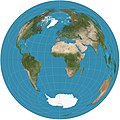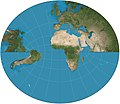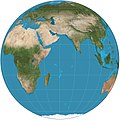Wikipedia:Featured picture candidates/Map Projections Set
Map Projections Set[edit]
Voting period is over. Please don't add any new votes. Voting period ends on 15 Jun 2013 at 19:47:12 (UTC)
- Reason
- There's a lot of images here (
434647!), and it's admittedly overwhelming. I have made this nomination before and feel it should have passed that time (The count for the then 20 images was +5/-2, and all of the quibbles have since been dealt with--I'll talk about this later). I'll also say up front that I by no means believe that all of these ultimately need to appear on the main page, a couple of the more interesting ones would probably suffice. If the List of map projections article one day becomes a FL, it would be a nice opportunity for some front page cross-pollination. But that's for later.
- Images of map projections are invaluable encyclopedically. The only other way to describe a projection is through formula which is rather difficult to visualize for, well, anyone. All of the images are clear, high-resolution (heights inevitably vary) and display the relevant features we would expect of maps--longitude, latitude, tropics of Cancer and Capricorn and the equator. Each image has its own article, for which it is the only possible illustration, and thus has great value. All of them appear on the list of projections; some of them have further applications. As a set, they can be compared side to side to highlight some of the more subtle differences between projections. The consistency between images and articles is unquestionably a boon for the project.
- At the previous nomination, users raised issues about the darkness of the images, prominence of lines of the map and the provenance of the images. These concerns are now dealt with. Strebe has remade most of the images and improved them greatly, in my opinion. The lines on the map now feature the Equator and tropics separately. They are a mere 1px in weight and as they are solid are less jarring than the previous dotted ones. The lightened oceans make it easier to read the maps and distinguish between land and water. The process for creating the images (as described on their pages) is that they are reprojections of NASA's Blue Marble image using Geocart. The consensus last nomination was the reapplication of mathematical formulas does not constitute OR.
- I have left a note on Strebe's talk page as he is deeply involved in work on map projections.
- Articles in which this image appears
- List of map projections, respective articles, + Assorted other applications
- FP category for this image
- Maps
- Creator
- Strebe
- Support as nominator --Cowtowner (talk) 19:47, 6 June 2013 (UTC)
- Added three more images, changed Peirce one to version used in article based on creator's recommendations. Cowtowner (talk) 06:42, 7 June 2013 (UTC)
- Question How is the size criteria applied to in sets? File:Collignon projection SW.jpg, for example, is small. – Kerαunoςcopia◁galaxies 21:05, 6 June 2013 (UTC)
- I thought about writing this in the nomination, but decided not too. Hindsight. All of the images are of a set width (~2058 pixels). Their heights vary by the math behind the respective projection. The size criteria is generally applied as it always is. In this case given that all of the images were produced to a standard and are of a high resolution I think in the case of the somewhat "small" images it can be relaxed Cowtowner (talk) 21:15, 6 June 2013 (UTC)
- As a followup, I suppose that I would add the purpose of the images is important. They aren't trying to show the actual detail of the earth's surface, but rather the shape that results from the various projections of its surface onto a 2D plane. I don't know that strictly enforcing that all images meet the 1500px height requirement helps with that goal beyond adding superflous pixels. Cowtowner (talk) 21:41, 6 June 2013 (UTC)
- Strong Oppose these are software generated, and small, no reason why they couldn't be generated significantly larger. EV here is questionable, so many can't possibly have that much EV for any pages they're on. A list page is marginal EV here, imho. Plus a list is essentially a gallery, which is also against criteria. — raekyt 06:28, 8 June 2013 (UTC)
- That's a hugely lazy review. They all have individual articles which were linked to in the gallery and list of the images. There is immense EV here. Also, as Strebe is abreast of the discussion, if the community feels that they need to be larger and that there is a tangible benefit to it, he maybe able to accomodate. Cowtowner (talk) 12:59, 8 June 2013 (UTC)
- Support. Images look good and encouraging this sort of consistent, high quality, wide-ranging collection of images is a good idea. P.s. Cowtowner, be more concise please. TCO (talk) 13:14, 8 June 2013 (UTC)
- Support. I think this set of images is very informative and well thought out. I think the sizes make sense, and they are very good for the purpose. They helped my understanding of the subject! Nofearnolimits 21:21, 8 June 2013 (UTC) — Preceding unsigned comment added by Nofearnolimits (talk • contribs)
- I quite like this set, but any chance of including some of the pythagorean solid-based projections, say the Dymaxion and the Cahill butterfly? Inclined to support, just think it'd be useful to include a missing map type. Adam Cuerden (talk) 14:54, 8 June 2013 (UTC)
- Cahill’s butterfly is not just a single projection. He devised many variations, promoting different ones at different times. The basic arrangement was always the same, but he experimented with different projection schemes, resulting in considerable change to the form of the basic lobe. His original scheme used an arbitrary projection that was not well explained, and he even made ad hoc adjustments to some of the lobes. None of the schemes achieved any great notoriety, so I feel uncomfortable “canonizing” any particular one.
- Fuller, too, promoted more than one scheme, and my discomfort is compounded by World Game claiming some sort of trademark right or copyright to the projection, the nature and extent of which is not clear to me, and while I am dubious of the claims’ legitimacy, have no interest in testing them. Strebe (talk) 20:32, 8 June 2013 (UTC)
- Also, with regards to the Dymaxion, we have featured this animation which at least demonstrates the concept. Cowtowner (talk) 23:18, 8 June 2013 (UTC)
- Support as creator Apparently the creator is allowed to vote. I will explain some of the rationale that went into the creation of these images. These principles were discussed before I replaced the ad hoc accumulation of images already present on the various projection pages.
- The base image is derived from NASA Blue Marble imagery, but the oceanic color has been replaced to be much lighter as well as pleasing regardless of monitor color and gamma variations.
- The resolution is a compromise between the need for useful thumbnail presentation and the need for useful base maps. For thumbnails, the lines of the graticule need to be abnormally thick; for actual maps using the full resolution of the imagery, they need to be thinner. Images of higher resolution would work poorly for thumbnails. Images of lower resolution would work poorly for any practical mapping.
- The projection technology reduces aliasing to near theoretical limits. A suite of map projection images of this diversity and quality has never been produced before, not even for research purposes.
- I felt a standardized width is more important than a standardized height because in Web presentation it is the page width that is the constraint.
- The software used to create these images implements far more map projections, so if and when new articles appear for those projections, they will be easily illustrated to the same standards.
- Strebe (talk) 20:57, 8 June 2013 (UTC)
- Question: it says the image is a "derivative of NASA’s Blue Marble summer month composite with oceans lightened to enhance legibility and contrast" - whose derivative? Grandiose (me, talk, contribs) 20:59, 8 June 2013 (UTC)
- It is the derivative that comes with the Geocart software. From the Geocart manual: “The maps you make with Geocart may be used however you see fit without license and without having to credit Geocart (though we would appreciate if you would when it is reasonable to do so).” From [1]: “Anyone using or republishing Blue Marble: Next Generation please credit 'NASA’s Earth Observatory.’” Strebe (talk) 21:12, 8 June 2013 (UTC)
- Support — Stigmatella aurantiaca (talk) 09:13, 9 June 2013 (UTC)
- Support it is certainly an extremely encyclopedic set. dllu (t,c) 03:17, 10 June 2013 (UTC)
- I have added another image which, by coincidence, was requested today for a new article. Strebe (talk) 06:25, 10 June 2013 (UTC)
Promoted File:Albers_projection_SW.jpg Armbrust The Homunculus 21:31, 15 June 2013 (UTC)
- And the other 46 images in the set. Armbrust The Homunculus 21:31, 15 June 2013 (UTC)













































